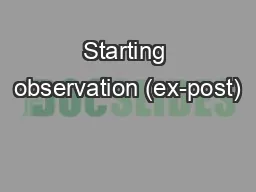

Eggertsson and Krugman 2012 Distributional shocks matter expost in the presence of ZLB type of constraints Series of papers by Jorda Taylor and Schularik provide some fascinating historical evidence ID: 489672
Download Presentation The PPT/PDF document "Starting observation (ex-post)" is the property of its rightful owner. Permission is granted to download and print the materials on this web site for personal, non-commercial use only, and to display it on your personal computer provided you do not modify the materials and that you retain all copyright notices contained in the materials. By downloading content from our website, you accept the terms of this agreement.
Slide1
Starting observation (ex-post)
Eggertsson and Krugman (2012)
Distributional shocks matter ex-post in the presence of ZLB type of constraints.
Series of papers by
Jorda
, Taylor and
Schularik
provide some fascinating historical evidence
Caution: not clear in the empirical literature that the ZLB is “necessary”
Possible tension with theory.
Would be nice to explore other possible frictions
Other workSlide2Slide3Slide4
Can monetary policy solve this problem?
Not reallySlide5
Ex-ante decision making
Is ex-ante borrowing / lending decision going to incorporate the ex-post (stochastic) macro effects of debt?
No, there is an “aggregate demand externality”
d
vs.
D
Get inefficient outcome even with complete markets
Farhi and Werning,
Korinek
and SimsekSlide6
Credit cycles and inequality
The discussion has to involve income and wealth inequality as well
Lenders and borrowers differ systematically
The paper is agnostic about the “timing” of credit cycles
But evidence suggests that the “credit cycle” is related to rising inequality
Could credit cycle be a GE “response” to
disequilibriating
forces? Slide7Slide8Slide9Slide10Slide11Slide12
Relevant forces outside of model
Non-standard preferences
What if a quarter to one-third of the population was myopic?
Fire sale externality
Equally important
Employment feedbackSlide13
Mandating change?
Mandating / subsidizing state-contingent financial contracts that automatically redistribute towards the more constrained agents ex-post
Getting rid of the bias induced by capital regulation
Getting rid of the bias induced by tax policy
Our financial regulation and tax policy makes no sense from a macro stability perspective.
This paper crystallizes some of the core issues in this debate.Slide14Slide15
Buying
a $200K
HomeSlide16
House Prices Drop 40%Slide17
Debt concentrates risk on the debtor – the lender largely escapes unscathed
Who are lenders? Debt and inequality naturally connected
Concentration of LossesSlide18
The Rich Lend to the PoorSlide19
The Distribution of Losses Matters
!Slide20
The aggregate demand feedbackSlide21
The employment feedbackSlide22
The fire-sale feedback